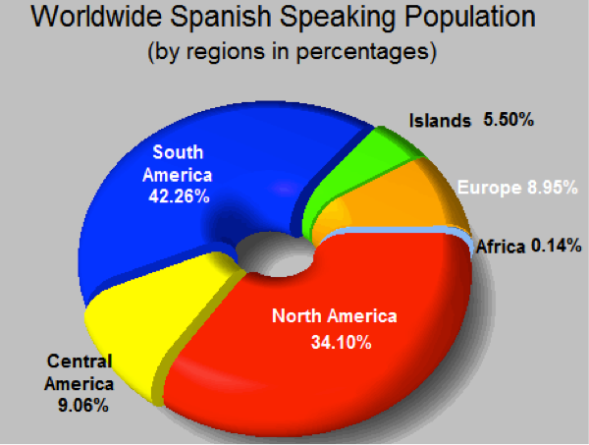
The importance of Spanish in international business
In order to successfully do business internationally, it is essential to have a strong knowledge of the culture and the language of the country in which a company is looking to operate, and Spanish, with more than 500 million speakers worldwide is one of the most important and strongest languages to consider when expanding and performing international transactions. Spanish is the third most used language on the Internet due to the continuous growth in the young and middle aged Spanish-speaking user base, as well as to the significant growth some South American countries are currently experiencing.
The Spanish-speaking population represents one of the biggest growing sectors in the world, especially in United States. This population embodies a huge community sharing products, services, and culture; presenting a great opportunity for growth for companies and institutions.
In order to better understand the importance of the Spanish language in the global business environment, there are some facts one must consider:
- Spanish is the official language in 21 countries, which makes it the third most spoken language after English and Mandarin.
- Spanish is the second most studied language after English.
- There are more than 400 million native Spanish speakers in the world, of which more than 50 million are living in the United States, a fact North American companies cannot ignore; heightening awareness as well as efforts to act accordingly.
- Last year, Traffic, an American digital media platform that connects advertisers with publishers, developed the first direct market for digital media inventory in Spanish.
- The Cervantes Institute estimates that in 2050, the United States will rank at the top, in terms of Spanish speakers, accounting for 30% of its population, which means that one out of three United States residents will be Hispanic.
Basically, the growth in the Spanish-speaking population and the fact that the Spanish language is frequently chosen as a second language, leads experts to believe that the 500 million Spanish speakers will continue to grow over the years.
Spanish in the Web
More Spanish words are being used in search engines each day and Google reports that the Spanish-speaking community has considerably grown in the last 4 years, becoming the third most used language in the Internet with a whopping 160 million users; having grown 650% between 2000 and 2012. One of the reasons for this growth is the development of digital press and the way Spanish speakers access the press trough their laptops and mobile devices.
Spain is the Spanish-speaking country with the highest percentage of Internet users (70%) of its total population. It is important to highlight that 95% of Spanish companies has access to the Internet and carries out part of its business online.
How to introduce your company into the Spanish-speaking market
When a company wants to start operating in a Spanish-speaking country, it is really important to work with native Spanish speakers or bilingual speakers that possess a strong knowledge of the language as well as in the culture of the country in which the company wishes to expand, not to mention the importance of adapting its product, website, and other communications to the desired market successfully. It is equally important to manage all of the company’s social media in Spanish, in order to achieve effective online communication with the end consumer.
Because most of these Spanish-speaking users are unwilling to use or consume products that are not localized, in addition to the fact that a great portion of them does not speak English, could make your company’s objective to reach them, impossible. Ultimately, the best way to reach the biggest number of users is to speak their own language in the web.



Leave a Reply